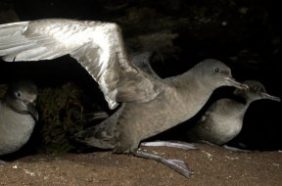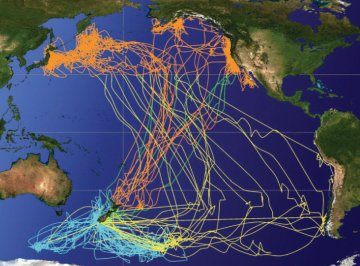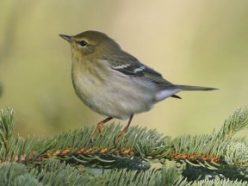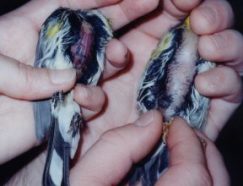A seabird’s endless summer
Food plays an important part in the migration of seabirds and songbirds.
Share this:
- Share via email (Opens in new window) Email
- Click to share on Facebook (Opens in new window) Facebook
- Click to share on X (Opens in new window) X
- Click to share on Pinterest (Opens in new window) Pinterest
- Click to share on Reddit (Opens in new window) Reddit
- Share to Google Classroom (Opens in new window) Google Classroom
- Click to print (Opens in new window) Print
It’s that time of year again. Many of the birds that have filled our backyards, parks, and forests with song are packing up and heading south for the winter.
For some songbirds, the trip may be as short as a jaunt from southern Wisconsin to Georgia. Other birds fly all the way from the northern forests of the United States and Canada to their winter homes in Central and South America.
But the gold medal for the longest migration flight doesn’t belong to a songbird. Instead, it rests with a small seabird called the sooty shearwater.
 |
|
A sooty shearwater.
|
| Darren Scott, University of Otago |
A team of scientists recently found that this bird has the longest migration route of any species in the animal kingdom. Sooty shearwaters travel more than 64,000 kilometers (39,000 miles) in a single year. That’s about one-and-a-half times the distance around the globe at the equator.
Why the long flight? The birds follow an “endless summer” of food supplies around the Pacific Ocean, says biologist Scott Shaffer of the University of California, Santa Cruz.
“They go to areas rich with food each season,” Shaffer says. “They leave the Southern Hemisphere in the fall, stay in our hemisphere in the spring, and leave in the fall. They don’t ever experience a true winter.”
Food plays an important part in the migration both of seabirds, such as sooty shearwaters, and of songbirds, such as warblers and thrushes. Now, scientists are uncovering new details of how these birds manage to travel long distances over open water.
Efficient flight
Shaffer and his team tracked sooty shearwaters using data recorders attached to small bands encircling the birds’ legs. The devices record a bird’s position as well as the air temperature and pressure. This information helps researchers determine when and where the birds dive for food.
 |
|
This map shows the travels of 19 sooty shearwaters during breeding and migration. Their tracks during breeding, near New Zealand, are shown in light blue. Yellow pathways represent their northward migratory routes. Orange lines show the birds’ wintering a
|
| © PNAS |
To power their impressive flights, sooty shearwaters rely on global ocean-wind patterns generated by waves, weather systems, and Earth’s rotation. “It’s like a conveyor belt of wind,” Shaffer says. “The birds get onto it, and it blows them westward.”
The birds also position their bodies to tack, as a sailboat does, moving at an angle to the prevailing wind direction, he says.
“These birds take advantage of all these winds and glide in a way that doesn’t cost them very much energy,” Shaffer says.
 |
|
Biologist Scott Shaffer tags a bird.
|
| Darren Scott, University of Otago |
But shearwaters still need to eat a lot to fuel their long-distance travels. Their routes cover large parts of the Pacific Ocean, targeting places where food is abundant at any given time of the year.
Energy supplies
All migrating birds, not just shearwaters, need ample supplies of energy to support their lengthy travels, says Russell Greenberg of the Smithsonian Institution Migratory Bird Center. In birds, much of this energy is stored as body fat.
Warblers, thrushes, and other songbirds, for example, belong to a large group called neotropical migrants. These birds spend the spring and summer in the forests of northern North America. They winter in the forests of Central and South America.
In preparation for migration, the birds gorge on insects, nuts, and berries each fall. “They eat and eat and eat,” Greenberg says. “Some of these birds almost double their body weight as they deposit fat.”
 |
|
Researcher Rebecca Holberton removes a blackpoll warbler from a net used to trap these birds for study.
|
| © Rebecca Holberton |
Migratory songbirds need to pig out because some species fly up to 5 days in a row without stopping to rest or fuel up. They can cover from 3,000 to 4,000 kilometers (1,900 to 2,500 miles) in a single flight. They cross bodies of water as large as the Gulf of Mexico, or even larger, says Rebecca Holberton, a biologist at the University of Maine.
And unlike seabirds, songbirds can’t land on the water if they get tired. They can’t dive for food. Instead, they pack on the pounds—or, in their case, ounces—and carry their energy stores with them.
“Our migratory songbirds are capable of extraordinary things,” Holberton says. “A lot of them cross the Gulf of Mexico in spring and fall, and that’s a good 20-hour trip.”
Ocean routes
Perhaps the most amazing songbird of all is the blackpoll warbler. In summer, this small black-and-white bird lives in forests stretching from Alaska to Nova Scotia. It spends the winter in the Amazon basin.
 |
|
A blackpoll warbler, photographed in Alaska, shows its fall colors.
|
| Donna Dewhurst, U.S. Fish and Wildlife Service |
As migration time nears, blackpoll warblers congregate in forests throughout New England. They then spend up to a week eating. As a result, they double or nearly triple their body weight before taking to the air. That would be like an average fifth-grade student ballooning from 88 pounds (40 kilograms) to 196 pounds (89 kilograms) in just a few days.
Why do the birds eat so much?
“Blackpoll warblers have evolved a unique migration strategy,” Holberton says. “The shortest route from New England to the Amazon basin, if you look on a globe, is to take off from the northeast United States and go out over the ocean.”
The warblers cover this route in a 3-to-5-day nonstop flight, traveling thousands of miles over open ocean. They eventually use up their fat stores, despite their premigration feasts. So, they turn to other sources of energy, Holberton says.
 |
|
A blackpoll warbler (right) gets much fatter than other birds, such as the yellow-rumped warbler on the left, that migrate much shorter distances.
|
| © Rebecca Holberton |
“The birds actually digest their digestive system, using some of the protein it is made of as another energy source,” she says.
This may sound strange, but it makes sense for the birds. “When you’re flying, you don’t need your gut,” Holberton says. Plus, digesting part of the digestive system makes the birds lighter in weight, which helps them conserve energy.
What happens when the birds complete their trans-Atlantic flight? “They can’t eat for a few hours, or even a day, after they’ve landed,” Holberton says. The birds need this time to regrow the organs that their bodies consumed in flight.
Climate change
While many songbirds migrate long distances over water just twice a year, seabirds such as sooty shearwaters spend up to 90 percent of their lives at sea.
Shearwaters are among the most abundant of all birds, and they cruise the entire Pacific Ocean to find food. But their numbers are falling in both the Northern and Southern Hemispheres.
By studying where these birds feed and fly, scientists hope to figure out the reasons for this decline. Shearwaters may serve as important indicators of what’s happening to ocean life and climate on a global scale.
Going Deeper:







